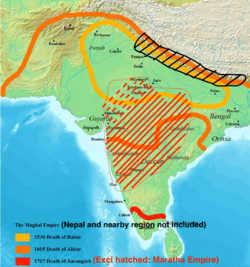Mughal Empire
| Mughal Empire | ||||||
| گورکانیان (Persian) Gūrkāniyān مغلیہ سلطنت (Urdu) Mug̱liyah Salṭanat | ||||||
| ||||||
| ||||||
|
The Mughal Empire at its greatest extent, in 1707 | ||||||
| Capital | Agra (1526–1540; 1555-1571) Fatehpur Sikri (1571–1585) Lahore (1585–1598) Agra (1598–1648) Shahjahanabad, Delhi (1648–1857) | |||||
| Languages | Chagatai Turkic (only initially) Persian (official and court language)[1] Urdu (spoken) | |||||
| Religion | Islam (1526–1857) Din-e Ilahi (1582–1605) | |||||
| Government | Absolute monarchy,unitary state with federal structure | |||||
| Emperor[2] | ||||||
| • | 1526–1530 | Babur (first) | ||||
| • | 1837–1857 | Bahadur Shah II (last) | ||||
| Historical era | Early modern | |||||
| • | First Battle of Panipat | 21 April 1526 | ||||
| • | Empire interrupted by Sur Empire | 1540-1555 | ||||
| • | Death of Aurangzeb | 3 March 1707 | ||||
| • | Siege of Delhi | 21 September 1857 | ||||
| Area | ||||||
| • | c.1690 - 1707[a] | 4,000,000 km²(1,544,409 sq mi) | ||||
| Population | ||||||
| • | 1650[b] est. | 145,000,000 | ||||
| Currency | Rupee | |||||
| Today part of | ||||||
| Outline of South Asian history |
|---|
The Mughal Empire (Urdu: مغلیہ سلطنت, Mug̱ẖliyah Salṭanat)[5] or Mogul Empire,[6] self-designated as Gurkani (Persian: گورکانیان, Gūrkāniyān, meaning "son-in-law"),[7] was an empire established and ruled by aPersianate[6][8] dynasty of Chagatai Turco-Mongol origin[9][10][11] that extended over large parts of the Indian subcontinent and Afghanistan.
The beginning of the empire is conventionally dated to the founder Babur's victory over Ibrahim Lodi, the last ruler of the Delhi Sultanate in the First Battle of Panipat (1526). The Mughal emperors were Central Asian Turco-Mongols belonging to the Timurid dynasty, who claimed direct descent from both Genghis Khan (founder of the Mongol Empire, through his sonChagatai Khan) and Timur (Turco-Mongol conqueror who founded theTimurid Empire). During the reign of Humayun, the successor of Babur, the empire was briefly interrupted by the Sur Empire. The "classic period" of the Mughal Empire started in 1556 with the ascension of Akbar the Great to the throne. Under the rule of Akbar and his son Jahangir, India enjoyed economic progress as well as religious harmony, and the monarchs were interested in local religious and cultural traditions. Akbar was a successful warrior. He also forged alliances with several Hindu Rajput kingdoms. SomeRajput kingdoms continued to pose a significant threat to Mughal dominance of northwestern India, but most of them were subdued by Akbar. All Mughal emperors were Muslims, except Akbar in the latter part of his life, when he followed a new religion called Deen-i-Ilahi, as recorded in historical books like Ain-e-Akbari and Dabestan-e Mazaheb.[12]
The Mughal Empire did not try to intervene in the local societies during most of its existence, but rather balanced and pacified them through new administrative practices[13][14] and diverse and inclusive ruling elites,[15]leading to more systematic, centralised, and uniform rule.[16] Newly coherent social groups in northern and western India, such as theMarathas, the Rajputs, the Pashtuns, the Hindu Jats and the Sikhs, gained military and governing ambitions during Mughal rule, which, through collaboration or adversity, gave them both recognition and military experience.[17][18][19][20]
The reign of Shah Jahan, the fifth emperor, between 1628–58 was the golden age of Mughal architecture. He erected several large monuments, the best known of which is the Taj Mahal at Agra, as well as the Moti Masjid, Agra, the Red Fort, the Jama Masjid, Delhi, and the Lahore Fort. The Mughal Empire reached the zenith of its territorial expanse during the reign of Aurangzeb and also started its terminal decline in his reign due toMaratha military resurgence under Shivaji Bhosale. During his lifetime, victories in the south expanded the Mughal Empire to more than 3.2 million square kilometres (1.2 million square miles), ruling over more than 150 million subjects, nearly one quarter of the world's population a the time, with a combined GDP of over $90 billion.[21][22]
By the mid-18th century, the Marathas had routed Mughal armies, and won over several Mughal provinces from the Punjab to Bengal,[23] and internal dissatisfaction arose due to the weakness of the Mughal Empire's administrative and economic systems, leading to the break-up of the empire and declaration of independence of its former provinces by the Nawabs of Bengal, Oudh, the Nizam of Hyderabad, Shah of Afghanistanand other small states. In 1739, the Mughals were crushingly defeated in the Battle of Karnal by the forces of Nader Shah, the founder of theAfsharid dynasty in Persia, and Delhi was sacked and looted, drastically accelerating their decline. During the following century Mughal power had become severely limited and the last emperor, Bahadur Shah II, had authority over only the city of Shahjahanabad. He issued a firmansupporting the Indian Rebellion of 1857 and following the defeat was therefore tried by the British East India Company for treason, imprisoned and exiled to Rangoon.[24] The last remnants of the empire were formally taken over by the British, and the Government of India Act 1858 let theBritish Crown formally assume direct control of India in the form of the newBritish Raj.
'연구하는 인생 > Histrory' 카테고리의 다른 글
| Mycenae Civilization (0) | 2015.12.15 |
|---|---|
| Timurid Empire 티무르 제국 (0) | 2015.12.14 |
| Acient Greece (0) | 2015.12.13 |
| 고대 그리스 (0) | 2015.12.13 |
| Ottoman Empire, Osman empire (0) | 2015.12.13 |


